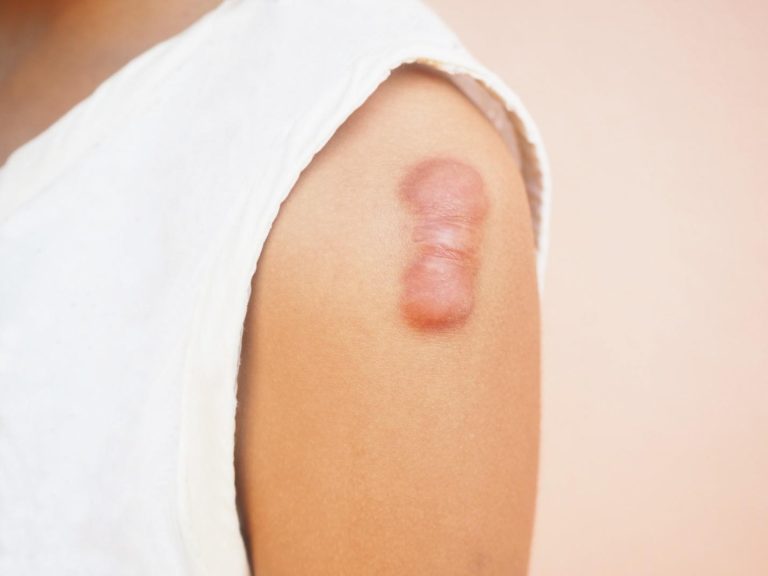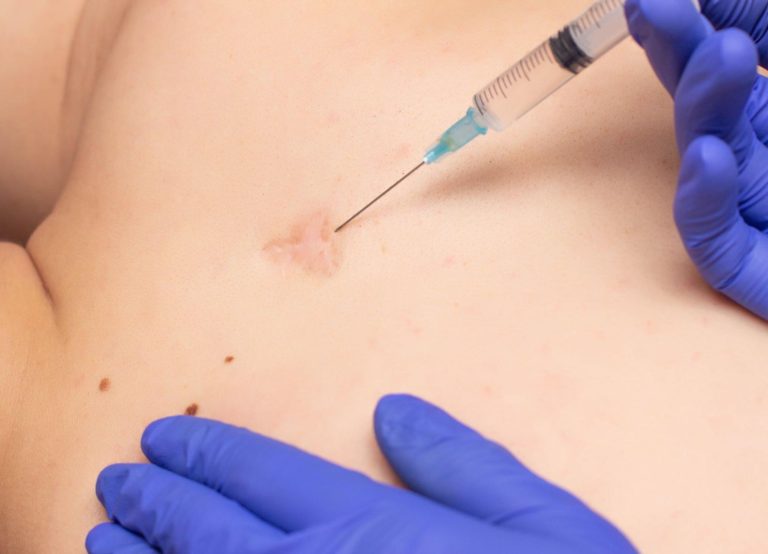

Scars are our body’s way of protecting us after the skin is injured. When the dermis is damaged, our body produces collagen fibres to repair the wound. This is laid down rapidly and densely, creating a scar.
However, when excess collagen is produced during the healing process, keloid scars can form. These are raised scars that form beyond the original wound — thick, raised, and sometimes, darker than the surrounding skin. While they do not pose serious health risks, their appearance, and potential discomfort can be distressing. Fortunately, various treatments are available to help reduce, and manage keloid scars, restoring both skin appearance and self-assurance.
Keloid scars are an overgrowth of scar tissue that forms at the site of a skin injury. Unlike regular scars, keloids extend beyond the original wound, and may continue to grow over time. This occurs due to excessive collagen production during the healing process. Instead of gradually fading, keloid scars become thick, raised, and sometimes itchy or uncomfortable. They can develop after minor skin injuries such as cuts, burns, acne or even piercings. Although harmless, their noticeable appearance can be a cosmetic concern for many individuals.
Identifying, and differentiating keloid scars is essential for seeking the right treatment. In fact, understanding their unique characteristics can help individuals determine the most ideal course of action.
Keloids can appear anywhere on the body but are more common in areas with high skin tension, and movement, including:
Keloid scars have distinct visual, and physical characteristics, such as:
Keloids form when the body produces excessive collagen while healing an injury. Collagen is a structural protein that helps repair, and strengthen the skin. However, in some individuals, an overproduction of collagen leads to the formation of keloid scars. Unfortunately, the exact reason behind this excessive collagen production remains unclear.
Keloids may develop after various skin injuries or conditions, including:

In addition to medical treatments, adopting a consistent skincare routine and avoiding known triggers can significantly improve the management of eczema.
The symptoms of keloid scars can vary but often include:
Although anyone can have keloid scars, there are certain individuals that are more prone to developing keloid scars due to genetic, and environmental factors. The risk factors include:
Several methods for assessing keloid scars include:

Treatment for keloid scars is tailored based on the severity, size, and location of the scar. At Livingstone Dermatology, our dermatologists may recommend one or a combination of the following treatment options:
While keloid scars can be persistent, and impact self-confidence, they are manageable with the right treatment approach. It is important to remember that early intervention is key to preventing excessive scar growth. At Livingstone Dermatology, we offer comprehensive keloid scar assessments, and medical-grade treatment options to help you achieve smoother, healthier skin. Contact us today for a personalised treatment plan.
Keloids are often mistaken for hypertrophic scars, a more common type of scarring. Hypertrophic scars are typically flat and vary in colour from pink to brown. They are smaller than keloids and, unlike keloids, may gradually fade over time.
Both men and women experience hypertrophic scars at similar rates, and they can affect individuals of all skin tones. These scars often result from physical or chemical injuries, such as piercings or exposure to harsh substances. Initially, hypertrophic scars may be itchy or painful, but these symptoms generally lessen as the skin heals.
Keloid scars are not always painful, but some people may experience discomfort, tenderness or itching in the affected area. The severity of symptoms varies from person to person, and larger keloids may cause more noticeable discomfort.
If pain or irritation is affecting your daily life, treatment options are available to help relieve symptoms and improve the appearance of the scar.
While keloid scars are not harmful to your overall health, they can sometimes lead to discomfort, restricted movement (if they develop over joints) or emotional distress due to their appearance. Additionally, keloids can sometimes continue to grow over time.
Most keloid treatments involve minimal downtime. Procedures like corticosteroid injections, laser therapy, and cryotherapy allow patients to resume normal activities almost immediately. However, surgical removal or radiation therapy may require a brief recovery period.
While keloid scars cannot always be entirely prevented, there are steps you can take to reduce the risk. If you are prone to keloids, avoid unnecessary piercings, tattoos, or elective surgeries. For necessary procedures, speak to a dermatologist about preventive measures such as silicone gel application, pressure dressings, or corticosteroid injections to minimise scarring.
Unlike normal scars that may fade over time, keloid scars tend to persist, and may even grow larger. Without treatment, they do not typically resolve on their own. However, there are various medical treatments available that can help shrink, flatten, and improve the appearance of keloid scars.
Yes, keloids have a tendency to recur, especially after surgical removal. To reduce the risk of recurrence, dermatologists often recommend combination treatments such as corticosteroid injections, laser therapy or radiation therapy after surgical excision.
Yes, keloid scars can be treated at any age, though treatment plans may vary depending on the patient’s skin type, age, and medical history. It is always best to consult a dermatologist to determine the most suitable treatment for your specific needs.
The timeframe for noticeable improvement depends on the treatment method used. Corticosteroid injections, laser therapy, and silicone sheets often require multiple sessions over weeks or months. Results from surgical removal or radiation therapy may become apparent sooner but require careful monitoring to prevent recurrence.
Whether you’re dealing with a specific skin concern or seeking to enhance your natural beauty, Livingstone Dermatology is here to guide you on your journey to healthy, radiant skin.
Schedule an appointment today and experience the Livingstone standard of care in a welcoming, professional environment.